The Easiest Fish to Take Care Of For Saltwater Tank Beginners
Are you eager to have a saltwater tank? It is time to do that. Do not worry about the fish maintenance. In today’s article, we will walk you through ten fish that are easy to care for in saltwater aquariums. Let’s get started right away.
Content Table
How difficult are saltwater fish to take care of
Keeping saltwater fish for beginners is challenging. Because saltwater fish are demanding water temperature, pH level, salinity, or other aquarium conditions. However, some saltwater fish are ideal for beginners, like clownfish. Next, we will list some saltwater fish and their care levels in this segment.
| Saltwater Fish | Care Level |
| Six-banded angelfish | difficult |
| Moorish idol | difficult |
| Ribbon eel | difficult |
| Flashlight fish | difficult |
| Pipefish | difficult |
| Band-tailed cardinal fish | moderate |
| Clownfish | easy |
| Royal gramma | easy |
| Six-line wrasse | easy |
| Green chromis | easy |
| White-tailed damselfish | easy |
Easiest fish to take care of
1. Clownfish
Featuring vibrant color, clownfish are hardy, active, and easy to keep. And they are popular among saltwater aquarists. By the way, for a clownfish tank, adding some anemones will be better, which makes reproduction easier. Additionally, Clownfish velvet is a common disease among them, you can do something to help the Clownfish in the sick in time to keep a healthy Clownfish tank.
| Family | Pomacentridae | 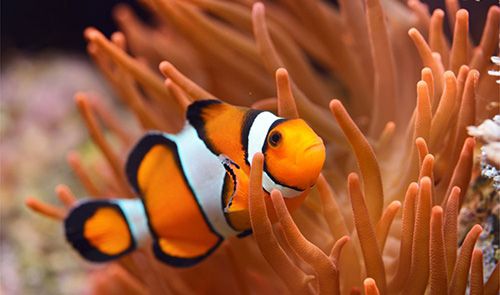 |
|
| Diet | Omnivore | ||
| Size | 2-5 inches | ||
| Lifespan | 3-10 years | ||
| Temperament | Peaceful | ||
| Minimum tank size | 30 gallons | pH level | 8.0-8.4 |
| Ideal water temperature | 75-80℉ | Salinity level | 1.020-1.024 |
2. Damselfish
With various patterns and colors, damselfish are hardy and one of the easiest saltwater fish to care for. However, they are aggressive and need adequate room to hide. As a result, you’d better keep damselfish in larger fish tanks.
| Family | Pomacentridae | 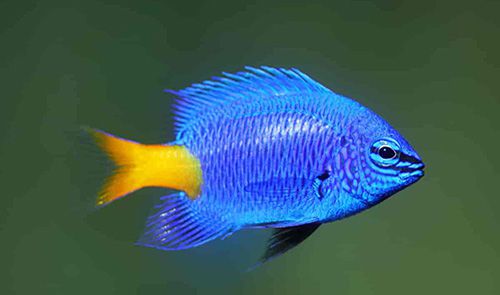 |
|
| Diet | Omnivore | ||
| Size | 2 inches | ||
| Lifespan | around 5 years | ||
| Temperament | Aggressive | ||
| Minimum tank size | 30 gallons | pH level | 8.0-8.4 |
| Ideal water temperature | 75-82℉ | Salinity level | around 1.025 |
3. Cardinalfish
Cardinal fish is an excellent alternative for beginners because they are hardy, peaceful, and adaptable. Moreover, they like to hide during the daytime and become active at night. Therefore, you should make sure enough hiding places, for instance, adding live aquarium plants, stones, rocks, tree trunks, or other aquarium decorations.
| Family | Apogonidae | 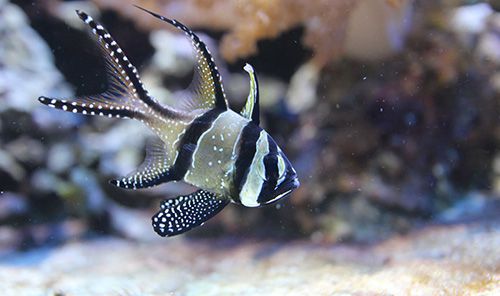 |
|
| Diet | Carnivore | ||
| Size | about 3 inches | ||
| Lifespan | 2.5-5 years | ||
| Temperament | Peaceful | ||
| Minimum tank size | 30 gallons | pH level | 8.1-8.4 |
| Ideal water temperature | 73-84℉ | Salinity level | 1.020-1.025 |
4. Royal gramma
Royal gramma is hardy and peaceful. Generally, it prefers a low light environment, like hiding in rocks or holes. Consequently, adding rocks to the tank is necessary. Besides that, royal gramma will be aggressive to their own species in small fish tanks. Thus, a larger tank above 30 gallons for one fish would be better.
| Family | Grammatidae | 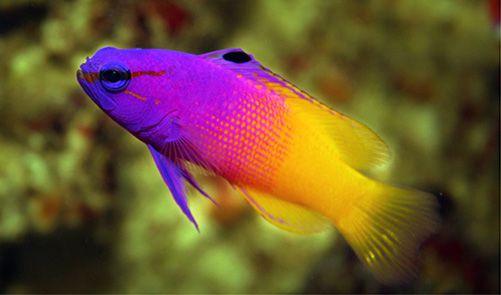 |
|
| Diet | Carnivore | ||
| Size | about 3 inches | ||
| Lifespan | 5-6 years | ||
| Temperament | Peaceful | ||
| Minimum tank size | 30 gallons | pH level | 8.1-8.4 |
| Ideal water temperature | 72-78℉ | Salinity level | 1.020-1.025 |
5. Blue-green chromis
Famous for its bright blue and green color, blue green chromis is hardy and the easiest fish to care for in marine tanks. Besides that, it is a schooling fish. Thus, it is better to keep blue green chromis in groups of three at least.
| Family | Pomacentridae | 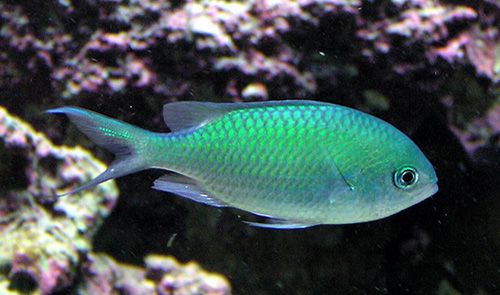 |
|
| Diet | Omnivore | ||
| Size | about 5 inches | ||
| Lifespan | 8-15 years | ||
| Temperament | Peaceful | ||
| Minimum tank size | 30 gallons | pH level | 8.1-8.4 |
| Ideal water temperature | 72-78℉ | Salinity level | 1.020-1.025 |
6. Six-line wrasse
Six-line wrasse is a small but active fish. It is also a great option for beginners. Nevertheless, it needs a living environment with plenty of hiding places. Furthermore, you’d better not keep it with small ornamental shrimp, as it will become aggressive to the shrimp.
| Family | Labridae | 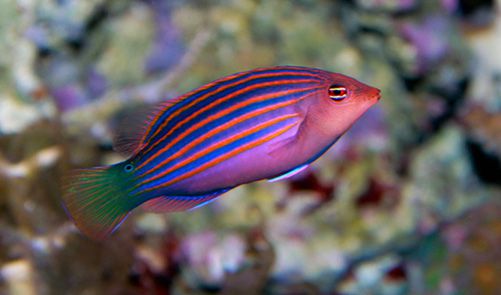 |
|
| Diet | Carnivore | ||
| Size | 3.9 inches | ||
| Lifespan | up to 10 years | ||
| Temperament | Peaceful | ||
| Minimum tank size | 30 gallon | pH level | 8.1-8.4 |
| Ideal water temperature | 72-78℉ | Salinity level | 1.022-1.025 |
7. Scooter blenny
Scooter blenny is a hardy and bottom-dwelling salt water fish. Also, it needs a saltwater tank with a deep sand substrate and live rocks. In addition, it can get along well with a wide range of other fish species, like mandarin dragonets.
| Family | Callionymidae | 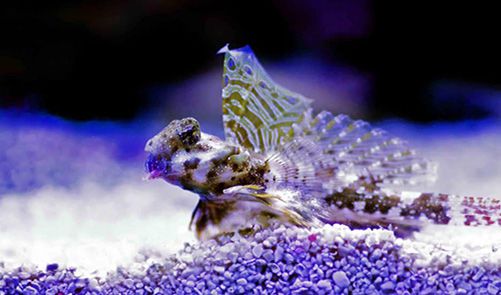 |
|
| Diet | Carnivore | ||
| Size | about 5 inches | ||
| Lifespan | about 2 years | ||
| Temperament | Peaceful | ||
| Minimum tank size | 30 gallons | pH level | 8.1-8.4 |
| Ideal water temperature | 77-81℉ | Salinity level | 1.023-1.026 |
8. Firefish goby
Firefish goby is fond of excavating in the sand to sleep and hiding in holes. As a result, you should provide sand, rocks, or other decorations in the firefish aquarium. One interesting thing is that it has a dorsal fin, which can defend against predators.
| Family | Microdesmidae | 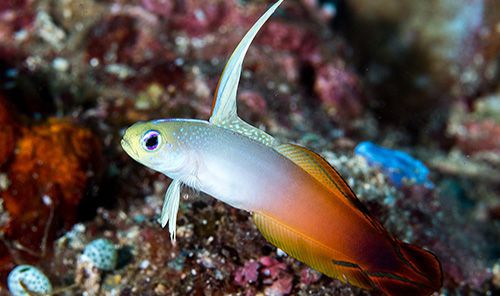 |
|
| Diet | Omnivore | ||
| Size | 2-3 inches | ||
| Lifespan | about 3 years | ||
| Temperament | Peaceful | ||
| Minimum tank size | 20 gallons | pH level | 8.1-8.4 |
| Ideal water temperature | 72-80℉ | Salinity level | 1.020-1.025 |
9. Green mandarin
Featuring brilliant green color, green mandarin is one of the easiest fish to take care of. Also, its scaleless body has orange and blue wavy lines. And its tail possesses blue edges. It is feasible to keep it with other peaceful fish species.
| Family | Callionymidae | 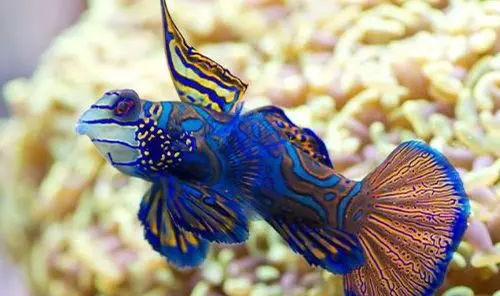 |
|
| Diet | Omnivore | ||
| Size | about 3 inches | ||
| Lifespan | 2-4 years | ||
| Temperament | Peaceful | ||
| Minimum tank size | 50 gallons | pH level | 8.1-8.4 |
| Ideal water temperature | 74-82℉ | Salinity level | 1.023-1.026 |
10. Clown goby
Clown goby is a perfect alternative for nano saltwater aquariums. However, you’d better not keep them with other fish or SPS corals. Because clown goby likes to lay eggs under branches.
| Family | Gobiidae | 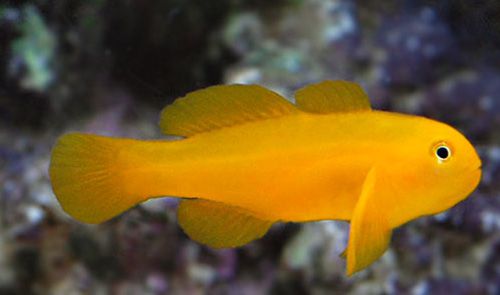 |
|
| Diet | Carnivore | ||
| Size | 1-1.5 inches | ||
| Lifespan | 2-6 years | ||
| Temperament | Peaceful | ||
| Minimum tank size | 10 gallons | pH level | 8.1-8.4 |
| Ideal water temperature | 72-78℉ | Salinity level | 1.020-1.025 |
In short, clownfish, royal gramma, and firefish goby are ideal options for saltwater community tanks. And the article What Types of Saltwater Fish Can Live in Community Tanks gives you more information about community tank fish.
How to properly care for fish in saltwater tanks
Considering that there are risks to keeping saltwater fish, this segment will share some tips about properly caring for the easiest saltwater fish in tanks.
- Water temperature: You should avoid temperature fluctuations, and make adjustments in time if the temperature is out of ideal ranges.
- Diet: Usually, you’d better feed them once or twice each day, and make sure that they can finish eating within about 2-3 minutes. On the other side, fish may have different diet requirements. Hence, you’d better make the diet schedule according to the specific saltwater fish.
- Health check: Check the color and observe the fish’s behavior to determine whether the fish are injured or get sick.
- Monitor the water parameters: Check the pH, nitrite, nitrate, total alkalinity, carbonate root, and free chlorine level once a week. The aquarium test strips will help you keep track of the water parameters.
- Do water changes: Generally, change 15-30 percent of water once a week. A siphon pump can change the water quickly by pressing the siphon ball. Also, it can clean every corner of your tank.
- Filtration system maintenance: Rinse the filter media and clean the aquarium filter once a month.
Reminder
Though the saltwater fish mentioned above are easy to care for and are ideal for beginners, you should be cautious when introducing them to your fish tank. It is best to quarantine the fish before adding them to your aquarium. By doing so, it reduces the risk of disease infection. Also, you should maintain optimal water conditions. Even keeping the easiest saltwater fish in your tank, it is recommended to collect their specific requirements of them first. You can find out more aquatic pets for your aquariums, and share them in the comments below.
That is all for today. Hope you will have a happy saltwater aquarium journey. Finally, thanks for your reading.
